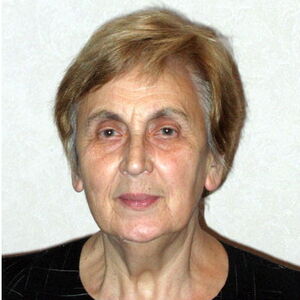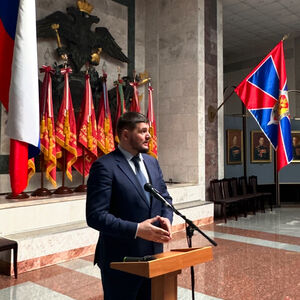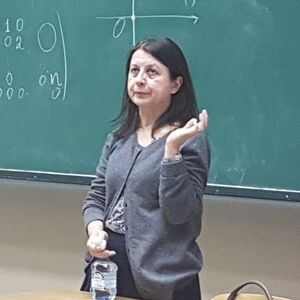2_results (732181), страница 4
Текст из файла (страница 4)
writeln('***********************************************************');
end;
procedure done; {final message}
begin
Sound(222); Delay(111); Sound(444); Delay(111); NoSound; {beep}
write('* Task processing time '); clock; saveTime;
writeln('* Status: Inverse problem has been successfully evaluated.');
end;
Begin
about;
loadData;
initParameters;
directTask;
for m:=1 to mLast do
begin
if fMulti then
begin
mCur:=m;
clockMessage;
end;
doMinimization; {main part of work}
setApproximationData( Rg, mCur ); {set new approx. data}
resultMessage;
if(( fMulti )AND( m < nPoints ))then reduceSILimits;
end;
done;
End.
П1.5 Модуль глобальных данных EData
Unit EData;
Interface
Uses DOS;
Const
maxPAR = 40; {nodes of approximation max number}
maxFUN = 20; {excitation frequencies max number}
maxSPC = 4; {support approximation values number}
iterImax = 50; {max number of internal iterations}
Const
apSpline = 1; {approximation type identifiers}
apHypTg = 3;
apExp = 2;
apPWCon = 4;
apPWLin = 8;
Type
Parameters = array[ 1..maxPAR ] of real; {Si,Mu data}
Functionals = array[ 1..maxFUN ] of real; {Voltage data}
SpecialPar = array[ 1..maxSPC ] of real; {Special data}
Var
hThick : real; {thickness of slab}
nPoints : integer; {nodes of approximation number within [ 0,H ]}
nLayers : integer; {number of piecewise constant SI layers within[ 0,H ]}
nFreqs : integer; {number of excitation frequencies}
nStab : integer; {required number of true digits in SI estimation}
epsU : real; {relative error of measurement Uvn*}
nApprox : byte; {approximation type identifier}
incVal : real; {step for numerical differ.}
parMaxH : integer; {max number of integration steps}
parMaxX : real; {upper bound of integration}
parEps : real; {error of integration}
derivType: byte; {1 for right; 2 for central}
Var
freqs : Functionals; {frequencies of excitment Uvn*}
Umr, Umi : Functionals; { Re(Uvn*),Im(Uvn*) for "measured" data}
Uer, Uei : Functionals; { Re(Uvn*),Im(Uvn*) for estimated data}
mu : Parameters; {relative permeability nodal values}
si, si0 : Parameters; {conductivity approximation nodal values}
siMin, siMax : Parameters; {conductivity nodal values restrictions}
par0 : SpecialPar; {alfa,si2,beta,gamma - for exp&HypTg}
parMin,parMax: SpecialPar; {-||- min/max}
zLayer : Parameters; {relative borders of slab layers [0,1]}
Var
aG : real; {scale factor for SImin/max}
Ft : real; {current discrepancy functional value}
fMulti : boolean; {TRUE if it isn't an EXP-approximation}
fHypTg : boolean; {TRUE for Hyperbolic tg approximation}
parEqlB : boolean; {TRUE if b[i]=const}
mCur : integer; {current number of approximation nodes}
inFileName : string; {data file name}
outFileName : string; {results file name}
Var
Rg : Parameters; {current SI estimation}
RgS : Parameters; {previous SI estimation}
Gr : array [ 1..2 ,1..maxPAR ] of real; {SI max/min}
Fh : array [ 1..maxPAR , 1..maxFUN ] of real; {current discrepancies}
Type
TTime=record
H, M, S, S100 : word; {hour,min,sec,sec/100}
end;
Var
clk1, clk2 : TTime; {start&finish time}
procedure loadData; {load all user-defined data from file}
Implementation
procedure loadData;
var
i,eqlB : integer;
FF : text;
begin
assign( FF, outFileName ); {clear output file}
rewrite( FF );
close( FF );
assign( FF, inFileName ); {read input file}
reset( FF );
readln( FF );
readln( FF );
readln( FF, hThick, nPoints, nLayers, nFreqs, nStab, epsU, aG, nApprox );
readln( FF );
for i:=1 to nFreqs do read( FF, freqs[i] );
readln( FF );
readln( FF );
readln( FF );
for i:=1 to nPoints do readln( FF, si[i], siMin[i], siMax[i] );
readln( FF );
readln( FF );
readln( FF , incVal, parMaxH, parMaxX, parEps, derivType, eqlB );
readln( FF );
readln( FF );
for i:=1 to maxSPC do readln( FF, par0[i] , parMin[i] , parMax[i] );
readln( FF );
if ( eqlB=0 )then
begin
for i:=1 to nLayers+1 do read( FF, zLayer[i] );
parEqlB:=false;
end
else parEqlB:=true;
close( FF );
for i:=1 to maxPAR do mu[i]:=1;
end;
Var
str : string;
Begin
if( ParamCount = 1 )then str:=ParamStr(1)
else
begin
write('Enter I/O file name, please: ');
readln( str );
end;
inFileName :=str+'.txt';
outFileName:=str+'.lst';
End.
П1.6 Модуль работы с файлами EFile
Unit EFile;
Interface
Uses
DOS, EData;
function isStable( ns : integer; var RG1,RG2 ) : boolean;
function saveResults( ns,iter : integer ) : boolean;
procedure saveExpResults;
procedure saveHypTgResults;
procedure clock;
procedure saveTime;
Implementation
Var
FF : text;
i : byte;
function decimalDegree( n:integer ) : real;{10^n}
var
s:real; i:byte;
begin
s:=1;
for i:=1 to n do s:=s*10;
decimalDegree:=s;
end;
function isStable( ns:integer ; var RG1,RG2 ) : boolean;
var
m : real;
R1 : Parameters absolute RG1;
R2 : Parameters absolute RG2;
begin
isStable:=TRUE;
m:=decimalDegree( ns-1 );
for i:=1 to mCur do
begin
if NOT(( ABS( R2[i]-R1[i] )*m )<=ABS( R2[i]) ) then isStable:=FALSE;
RgS[i]:=Rg[i];
end;
end;
function saveResults( ns , iter : integer ) : boolean;
var
sum : real;
begin
sum:=0;
for i:=1 to nFreqs do sum:=sum + Fh[1,i];
sum:=SQRT( sum/nFreqs );
assign( FF , outFileName );
append( FF );
write( iter:2, ' ', sum:10:7, ' Rg=' );
write( FF , iter:2, ' ', sum:10:7, ' Rg=');
for i:=1 to mCur do
begin
write( Rg[i]:6:3, ' ');
write( FF , Rg[i]:6:3, ' ');
end;
writeln;
writeln( FF );
close( FF );
saveResults:=isStable( ns , Rgs , Rg );
end;
procedure saveExpResults;
begin
assign( FF , outFileName );
append( FF );
writeln( ' siE=',Rg[2]:6:3,' siI=',Rg[1]:6:3,' alfa=',Rg[3]:6:3);
writeln( FF , ' siE=',Rg[2]:6:3,' siI=',Rg[1]:6:3,' alfa=',Rg[3]:6:3);
write( ' SI: ');
write( FF , ' SI: ');
for i:=1 to nPoints do
begin
write( si[i]:6:3,' ');
write( FF , si[i]:6:3,' ');
end;
writeln;
writeln( FF );
close( FF );
end;
procedure saveHypTgResults;
begin
assign( FF , outFileName );
append( FF );
writeln( ' si1=',Rg[2]:6:3,' si2=',Rg[1]:6:3,' beta=',Rg[3]:6:3,' gamma=',Rg[4]:6:3);
writeln( FF , ' si1=',Rg[2]:6:3,' si2=',Rg[1]:6:3,' beta=',Rg[3]:6:3,' gamma=',Rg[4]:6:3);
write( ' SI: ');
write( FF , ' SI: ');
for i:=1 to nPoints do
begin
write( si[i]:6:3,' ');
write( FF , si[i]:6:3,' ');
end;
writeln;
writeln( FF );
close( FF );
end;
procedure clock; {t2 = t2-t1}
var
H1,M1,S1,H2,M2,S2,sec1,sec2 : longint;
begin
GetTime( clk2.H, clk2.M, clk2.S, clk2.S100 ); {current time}
H2:=clk2.H; M2:=clk2.M; S2:=clk2.S; H1:=clk1.H; M1:=clk1.M; S1:=clk1.S;
sec2:= ( H2*60 + M2 )*60 + S2;
sec1:= ( H1*60 + M1 )*60 + S1;
if( sec2 < sec1 )then sec2:=sec2 + 85020; {+23.59.59}
sec2:=sec2 - sec1;
clk2.H := sec2 div 3600; sec2:=sec2 - clk2.H*3600;
clk2.M := sec2 div 60; sec2:=sec2 - clk2.M*60;
clk2.S := sec2;
writeln( clk2.H:2, ':', clk2.M:2, ':', clk2.S:2 );
end;
procedure saveTime;
begin
assign( FF , outFileName );
append( FF );
write( FF ,'* Processing time ',clk2.H:2, ':', clk2.M:2, ':', clk2.S:2 );
close( FF );
end;
End.
П1.7 Модуль решения прямой задачи ВТК для НВТП EDirect
{****************************************************************************}
{ ERIN submodule : EDirect , 15.02.99, (C) 1999 by Nikita U.Dolgov }
{****************************************************************************}
{ Estimates Uvn* for Eddy current testing of inhomogeneous multilayer slab }
{ with surface( flat ) probe. }
{ It can do it using one of five types of conductivity approximation : }
{Spline, Exponential, Piecewise constant, Piecewise linear,Hyperbolic tangent}
{****************************************************************************}
{$F+}
Unit EDirect;
Interface
Uses EData, EMath;
Type
siFunc = function( x:real ) : real;
Var
getSiFunction : siFunc; {for external getting SI estimate}
procedure initConst( par1,par2:integer; par3,par4:real; par5:boolean );
procedure getVoltage( freq : real ; var ur,ui : real ); { Uvn* = ur + j*ui }
procedure setApproximationType( approx : byte ); { type of approx. }
procedure setApproximationItem( SIG:real ; N : byte ); { set SIGMA[ N ]}
procedure setApproximationData( var SIG; nVal : byte ); { SIGMA[1..nVal] }
procedure getApproximationData( var SIG ; var N : byte ); { get SIGMA[ N ]}
Implementation
Const
PI23 = 2000*pi; {2*pi*KHz}
mu0 = 4*pi*1E-7; {magnetic const}
Var
appSigma : Parameters; {conductivity approximation data buffer}
appCount : byte; {size of conductivity approximation data buffer}
appType : byte; {conductivity approximation type identifier}
Type
commonInfo=record
w : real; {cyclical excitation frecuency}
R : real; {equivalent radius of probe}
H : real; {generalized lift-off of probe}
Kr : real; {parameter of probe}
eps : real; {error of integration}
xMax : real; {upper bound of integration}
steps : integer; {current number of integration steps}
maxsteps: integer; {max number of integration steps}
Nlay : integer; {number of layers in slab}
sigma : Parameters; {conductivity of layers}
m : Parameters; {relative permeability of layers}
b : Parameters; {thickness of layers}
zCentre : Parameters; {centre of layer}
end;
procFunc = procedure( x:real; var result:complex);
Var
siB, siC, siD : Parameters; {support for Spline approx.}
cInfo : commonInfo; {one-way access low level info}
function siSpline( x:real ) : real;{Spline approximation}
begin
if( appCount = 1 )then
siSpline := appSigma[ 1 ]
else
siSpline:=Seval( appCount, x, appSigma, siB, siC, siD);
end;
function siExp( x:real ) : real;{Exponential approximation}
begin
siExp:=(appSigma[2]-appSigma[1])*EXP( -appSigma[3]*(1-x) ) + appSigma[1];
end;
function siPWConst( x:real ) : real;{Piecewise constant approximation}
var
dx, dh : real; i : byte;
begin
if( appCount = 1 )then siPWConst := appSigma[ 1 ]
else
begin
dh:=1/( appCount-1 );
dx:=dh/2;
i:=1;
while( x > dx ) do
begin
i:=i + 1;
dx:=dx + dh;
end;
siPWConst:=appSigma[ i ];
end;
end;
function siPWLinear( x:real ) : real;{Piecewise linear approximation}
var
dx, dh : real;
i : byte;
begin
if( appCount = 1 )then siPWLinear := appSigma[ 1 ]
else
begin
dh:=1/( appCount-1 );
dx:=0;
i:=1;
repeat
i:=i + 1;
dx:=dx + dh;
until( x <= dx );
siPWLinear:=appSigma[i-1]+( appSigma[i]-appSigma[i-1] )*( x/dh+2-i);
end;
end;
function siHyperTg( x:real ) : real;{Hyperbolic tangent approximation}
begin
siHyperTg:=appSigma[2]+(appSigma[1]-appSigma[2])*(1+th((appSigma[3]-x)/appSigma[4]))/2;
end;
procedure setApproximationType( approx : byte );
begin
appType := approx;
write('* conductivity approximation type : ');
case approx of
apSpline : begin
writeln('SPLINE');
getSiFunction := siSpline;
end;
apExp : begin
writeln('EXP');
getSiFunction := siExp;
end;
apPWCon : begin
writeln('PIECEWISE CONST');
getSiFunction := siPWConst;
end;
apPWLin : begin
writeln('PIECEWISE LINEAR');
getSiFunction := siPWLinear;
end;
apHypTg : begin
writeln('HYPERBOLIC TANGENT');
getSiFunction := siHyperTg;
end;
end;
end;
procedure setApproximationData( var SIG ; nVal : byte );
var
Sigma : Parameters absolute SIG; i:byte;
begin
appCount := nVal;
for i:=1 to nVal do appSigma[ i ]:=Sigma[ i ];
if( appType = apSpline )then Spline( appCount, appSigma, siB, siC, siD);
end;
procedure getApproximationData( var SIG ; var N : byte );
var
Sigma : Parameters absolute SIG; i:byte;
begin
N := appCount;
for i:=1 to appCount do Sigma[ i ]:=appSigma[ i ];
end;
procedure setApproximationItem( SIG:real ; N : byte );
begin
appSigma[ N ] := SIG;
if( appType = apSpline )then Spline( appCount, appSigma, siB, siC, siD);
end;
procedure functionFi( x:real ; var result:complex );{get boundary conditions function value}
var
beta : array[ 1..maxPAR ]of real;
q : array[ 1..maxPAR ]of complex;
fi : array[ 0..maxPAR ]of complex;
th , z1 , z2 , z3 , z4 , z5 , z6 , z7 : complex;
i : byte;
begin
mkComp( 0, 0, fi[0] );
with cInfo do
for i:=1 to Nlay do
begin
beta[i]:=R*sqrt( w*mu0*sigma[i] ); {calculation of beta}
mkComp( sqr(x), sqr(beta[i])*m[i], z7 ); {calculation of q, z7=q^2}
SqrtC( z7, q[i] );
mulComp( q[i], b[i], z6 ); {calculation of th,z6=q*b}
tanH( z6, th ); {th=tanH(q*b)}
mkComp( sqr(m[i])*sqr(x), 0, z6 ); {z6=m2x2}
SubC( z6, z7, z5); {z5=m2x2-q2}
AddC( z6, z7, z4); {z4=m2x2+q2}
MulC( z5, th, z1); {z1=z5*th}
MulC( z4, th, z2); {z2=z4*th}
mulComp( q[i], 2*x*m[i], z3 ); {z3=2xmq}
SubC( z2, z3, z4 );
MulC( z4, fi[i-1], z5 );
SubC( z1, z5, z6 ); {z6=high}
AddC( z2, z3, z4 );
MulC( z1, fi[i-1], z5 );
SubC( z4, z5, th ); {th=low}
DivC( z6, th, fi[i] );
end;
eqlComp( result, fi[ cInfo.Nlay ] );
end;
procedure funcSimple( x:real; var result:complex );{intergrand function value}
var
z : complex;
begin
with cInfo do
begin
functionFi( x, result );
mulComp( result, exp( -x*H ), z );
mulComp( z, J1( x*Kr ), result );
mulComp( result, J1( x/Kr ), z );
eqlComp( result, z );
end;
end;
procedure funcMax( x:real; var result:complex );{max value; When Fi[Nlay]=1}
var
z1, z2 : complex;
begin
with cInfo do
begin
mkComp( 1,0,z1 );
mulComp( z1, exp(-x*H), z2 );
mulComp( z2, J1( x*Kr ), z1 );
mulComp( z1, J1( x/Kr ), result );
end;
end;
procedure integralBS( func:procFunc ; var result:complex );{integral by Simpson}
var
z , y , tmp : complex;
hh : real;
i, iLast : word;
begin
with cInfo do
begin
hh:=xMax/steps;
iLast:=steps div 2;
nullComp(tmp);
func( 0, z );
eqlComp( y, z );
for i:=1 to iLast do
begin
func( ( 2*i-1 )*hh , z );
deltaComp( tmp, z );
end;
mulComp( tmp, 4, z );
deltaComp( y, z );
nullComp( tmp );
iLast:=iLast-1;
for i:=1 to iLast do
begin
func( 2*i*hh ,z );
deltaComp( tmp, z );
end;
mulComp( tmp, 2, z );
deltaComp( y, z );
func( xmax, z );
deltaComp(y,z);
mulComp( y, hh/3, z );
eqlComp( result, z );
end;
end;{I = h/3 * [ F0 + 4*sum(F2k-1) + 2*sum(F2k) + Fn ]}
procedure integral( F:procFunc; var result:complex );{integral with given error}
var
e , e15 : real;
flag : boolean;
delta , integ1H , integ2H : complex;
begin
with cInfo do
begin
e15 :=eps*15;{ | I2h-I1h |/(2^k -1 )< Eps ; k=4 for Simpson method}
steps:=20;
flag :=false;
integralBS( F, integ2H );
repeat
eqlComp( integ1H, integ2H );
steps:=steps*2;
integralBS( F, integ2H );
SubC( integ2H, integ1H, delta );
e:=Leng( delta );
if( e until( ( flag ) OR (steps>maxsteps) ); if( flag )then begin eqlComp( result, integ2H ); end else begin writeln('Error: Too big number of integration steps.'); halt(1); end; end; end; procedure initConst( par1, par2 : integer; par3, par4 : real; par5:boolean ); var i : byte; bThick, dl, x : real; const Ri=0.02; hi=0.005; { radius and lift-off of excitation coil} Rm=0.02; hm=0.005; { radius and lift-off of measuring coil} begin with cInfo do begin Nlay :=par1; xMax :=par3; maxsteps:=par2; R :=sqrt( Ri*Rm ); H :=( hi+hm )/R; Kr :=sqrt( Ri/Rm ); eps :=par4; bThick :=hThick*0.002/R; {2*b/R [m]} for i:=1 to Nlay do m[i]:= mu[i]; if par5 then begin bThick:=bThick/NLay; for i:=1 to Nlay do b[i]:=bThick; dl:=1/NLay; x:=dl/2; {x grows up from bottom of slab to the top} for i:=1 to Nlay do begin zCentre[i]:=x; x:=x + dl; end; end else for i:=1 to Nlay do begin b[i]:=( zLayer[i+1]-zLayer[i] )*bThick; zCentre[i]:=( zLayer[i+1]+zLayer[i] )/2; end; end; end; procedure init( f:real );{get current approach of conductivity values} var i : byte; begin with cInfo do begin w:=PI23*f; for i:=1 to Nlay do sigma[i]:=getSiFunction( zCentre[i] )*1E6; end; end; procedure getVoltage( freq : real ; var ur,ui : real ); var U, U0, Uvn, tmp : complex; begin init( freq ); integral( funcSimple, U ); { U =Uvn } integral( funcMax , U0 ); { U0=Uvn max } divComp( U, Leng(U0), Uvn ); { Uvn=U/|U0| } mkComp( 0, 1, tmp ); { tmp=( 0+j1 ) } MulC( tmp, Uvn, U ); { U= j*Uvn = Uvn* } ur := U.re; ui := U.im; end; END. П1.8 Модуль решения обратной задачи ВТК для НВТП EMinimum Unit EMinimum; INTERFACE Uses EData, Crt, EFile, EDirect; procedure doMinimization; IMPLEMENTATION procedure getFunctional( Reg : byte ); var ur, ui, dur, dui, Rgt : real; ur2, ui2: Functionals; i, j, k : byte; begin getApproximationData( si , k ); setApproximationData( Rg, mCur ); case Reg of 0 : for i:=1 to nFreqs do {get functional F value} begin getVoltage( freqs[i], ur, ui ); Uer[ i ]:=ur; {we need it for dU} Uei[ i ]:=ui; Fh[1,i] := SQR( ur-Umr[i] ) + SQR( ui-Umi[i] ); end; {Right:U'(i)= (U(i+1)-U(i))/h} 1 : for i:=1 to mCur do {get dF/dSI[i] value} begin Rgt:=Rg[i]*( 1+incVal ); {si[i]=si[i]+dsi[i]} setApproximationItem( Rgt, i ); {set new si[i] value} for j:=1 to nFreqs do begin {get dUr/dSI,dUi/dSI} getVoltage( freqs[ j ], ur, ui ); dur:=( ur-Uer[j] )/( Rg[i]*incVal ); dui:=( ui-Uei[j] )/( Rg[i]*incVal ); Fh[i,j]:=2*(dur*(Uer[j]-Umr[j])+dui*(Uei[j]-Umi[j])); end; setApproximationItem( Rg[i], i ); {restore si[i] value} end; {Central:U'(i)= (U(i+1)-U(i-1))/2h} 2 : for i:=1 to mCur do {get dF/dSI[i] value} begin Rgt:=Rg[i]*( 1+incVal ); {si[i]=si[i]+dsi[i]} setApproximationItem( Rgt, i ); {set new si[i] value} for j:=1 to nFreqs do getVoltage( freqs[j],ur2[j],ui2[j] ); Rgt:=Rg[i]*( 1-incVal ); {si[i]=si[i]-dsi[i]} setApproximationItem( Rgt, i ); {set new si[i] value} for j:=1 to nFreqs do begin {get dUr/dSI,dUi/dSI} getVoltage( freqs[ j ], ur, ui ); dur:=( ur2[j]-ur )/( 2*Rg[i]*incVal ); dui:=( ui2[j]-ui )/( 2*Rg[i]*incVal ); Fh[i,j]:=2*(dur*(Uer[j]-Umr[j])+dui*(Uei[j]-Umi[j])); end; setApproximationItem( Rg[i], i ); {restore si[i] value} end; end; setApproximationData( si , k ); end; procedure doMinimization; const mp1Max = maxPAR + 1; mp2Max = maxPAR + 2; m2Max = 2*( maxPAR + maxFUN ); m21Max = m2Max + 1; n2Max = 2*maxFUN; m1Max = maxPAR + n2Max; n1Max = n2Max + 1; mm1Max = maxPAR + n1Max; minDh : real = 0.001; {criterion of an exit from golden section method} var A : array [ 1 .. m1Max , 1 .. m21Max ] of real; B : array [ 1 .. m1Max] of real; Sx: array [ 1 .. m21Max] of real; Zt: array [ 1 .. maxPAR] of real; Nb: array [ 1 .. m1Max] of integer; N0: array [ 1 .. m21Max] of integer; a1, a2, dh, r, tt, tp, tl, cv, cv1, cl, cp : real; n2, n1, mp1, mp2, mm1, m1, m2, m21 : integer; ain : real; apn : real; iq : integer; k1 : integer; n11 : integer; ip : integer; iterI : integer; i,j,k : integer; label 102 ,103 ,104 ,105 ,106 ,107 ,108; begin n2:=2*nFreqs; n1:=n2+1; m1:=mCur+n2; mp1:=mCur+1; mp2:=mCur+2; mm1:=mCur+n1; m2:=2*( mCur+nFreqs ); m21:=m2+1; for k:=1 to m1Max do for i:=1 to m21Max do A[k,i]:=0; iterI:=0; 102: iterI:=iterI+1; getFunctional( 0 ); for i:=1 to nFreqs do b[i]:= -Fh[1,i]; getFunctional( derivType ); for k:=1 to mCur do begin Zt[k]:=Rg[k]; for i:=1 to nFreqs do begin A[i,k+1]:=Fh[k,i]; A[i+nFreqs,k+1]:=-A[i,k+1]; end; for i:=1 to nFreqs do B[i]:=B[i]+Rg[k]*A[i,k+1]; end; for i:=1 to nFreqs do B[i+nFreqs]:=-B[i]; for i:=n1 to m1 do B[i]:=Gr[1,i-n2]-Gr[2,i-n2]; for i:=1 to m1 do begin if i<=n2 then for k:=2 to mp1 do B[i]:=B[i]-A[i,k]*Gr[2,k-1]; A[i,1]:=-1; if i>n2 then begin A[i,1]:=0; for k:=2 to mp1 do if i-n2=k-1 then A[i,k]:=1 else A[i,k]:=0; end; for k:=mp2 to m21 do if k-mp1=i then A[i,k]:=1 else A[i,k]:=0; end; k1:=1; for k:=1 to n2 do if B[k1]>B[k] then k1:=k; for k:=1 to mp1 do A[k1,k]:=-A[k1,k]; A[k1,mCur+1+k1]:=0; B[k1]:=-B[k1]; for i:=1 to n2 do if i<>k1 then begin B[i]:=B[i]+B[k1]; for k:=1 to mm1 do A[i,k]:=A[i,k]+A[k1,k]; end; for i:=mp2 to m21 do begin Sx[i]:=B[i-mp1]; Nb[i-mp1]:=i; end; for i:=1 to mp1 do Sx[i]:=0; Sx[1]:=B[k1]; Sx[mp1+k1]:=0; Nb[k1]:=1; 103: for i:=2 to m21 do N0[i]:=0; 104: for i:=m21 downto 2 do if N0[i]=0 then n11:=i; for k:=2 to m21 do if ((A[k1,n11] if A[k1,n11]<=0 then goto 105; iq:=0; for i:=1 to m1 do if i<>k1 then begin if A[i,n11]>0 then begin iq:=iq+1; if iq=1 then begin Sx[n11]:=B[i]/A[i,n11]; ip:=i; end else begin if Sx[n11]>B[i]/A[i,n11] then begin Sx[n11]:=B[i]/A[i,n11]; ip:=i; end; end; end else if iq=0 then begin N0[n11]:=n11; goto 104; end; end; Sx[Nb[ip]]:=0; Nb[ip]:=n11; B[ip]:=B[ip]/A[ip,n11]; apn:=A[ip,n11]; for k:=2 to m21 do A[ip,k]:=A[ip,k]/apn; for i:=1 to m1 do if i<>ip then begin ain:=A[i,n11]; B[i]:=-B[ip]*ain+B[i]; for j:=1 to m21 do A[i,j]:=-ain*A[ip,j]+A[i,j]; end; for i:=1 to m1 do Sx[Nb[i]]:=B[i]; goto 103; 105: for k:=1 to mCur do Sx[k+1]:=Sx[k+1]+Gr[2,k]; a1:=0; a2:=1.; dh:=a2-a1; r:=0.618033; tl:=a1+r*r*dh; tp:=a1+r*dh; j:=1; 108: if j=1 then tt:=tl else tt:=tp; 106: for i:=1 to mCur do Rg[i]:=Zt[i]+tt*(Sx[i+1]-Zt[i]); getFunctional( 0 ); cv:=abs(Fh[1,1]); if nFreqs>1 then for k:=2 to nFreqs do begin cv1:=abs(Fh[1,k]); if cv end; if (j=1) or (j=3) then cl:=cv else cp:=cv; if j=1 then begin j:=2; goto 108; end; if dh if cl>cp then begin a1:=tl; dh:=a2-a1; tl:=tp; tp:=a1+r*dh ; tt:=tp; cl:=cp; j:=4; end else begin a2:=tp; dh:=tp-a1; tp:=tl; tl:=a1+r*r*dh; tt:=tl; cp:=cl; j:=3; end; goto 106; 107: if (iterI < iterImax)AND(NOT saveResults( nStab,iterI )) then goto 102; end; End. Приложение 2 - Удельная электрическая проводимость материалов Приведем сводку справочных данных согласно[7-9]. Материал smin ,[МСм/м] smax ,[МСм/м] Немагнитные стали 0.4 1.8 Бронзы (БрБ, Бр2, Бр9) 6.8 17 Латуни (ЛС59, ЛС62) 13.5 17.8 Магниевые сплавы (МЛ5-МЛ15) 5.8 18.5 Титановые сплавы (ОТ4, ВТ3-ВТ16) 0.48 2.15 Алюминиевые сплавы (В95, Д16, Д19) 15.1 26.9 Приложение 4 - Abstract The inverse eddy current problem can be described as the task of reconstructing an unknown distribution of electrical conductivity from eddy-current probe voltage measurements recorded as function of excitation frequency. Conductivity variation may be a result of surface processing with substances like hydrogen and carbon or surface heating. Mathematical reasons and supporting software for inverse conductivity profiling were developed by us. Inverse problem was solved for layered plane and cylindrical conductors. Because the inverse problem is nonlinear, we propose using an iterative algorithm which can be formalized as the minimization of an error functional related to the difference between the probe voltages theoretically predicted by the direct problem solving and the measured probe voltages. Numerical results were obtained for some models of conductivity distribution. It was shown that inverse problem can be solved exactly in case of correct measurements. Good estimation of the true conductivity distribution takes place also for measurement noise about 2 percents but in case of 5 percent error results are worse. 56
















